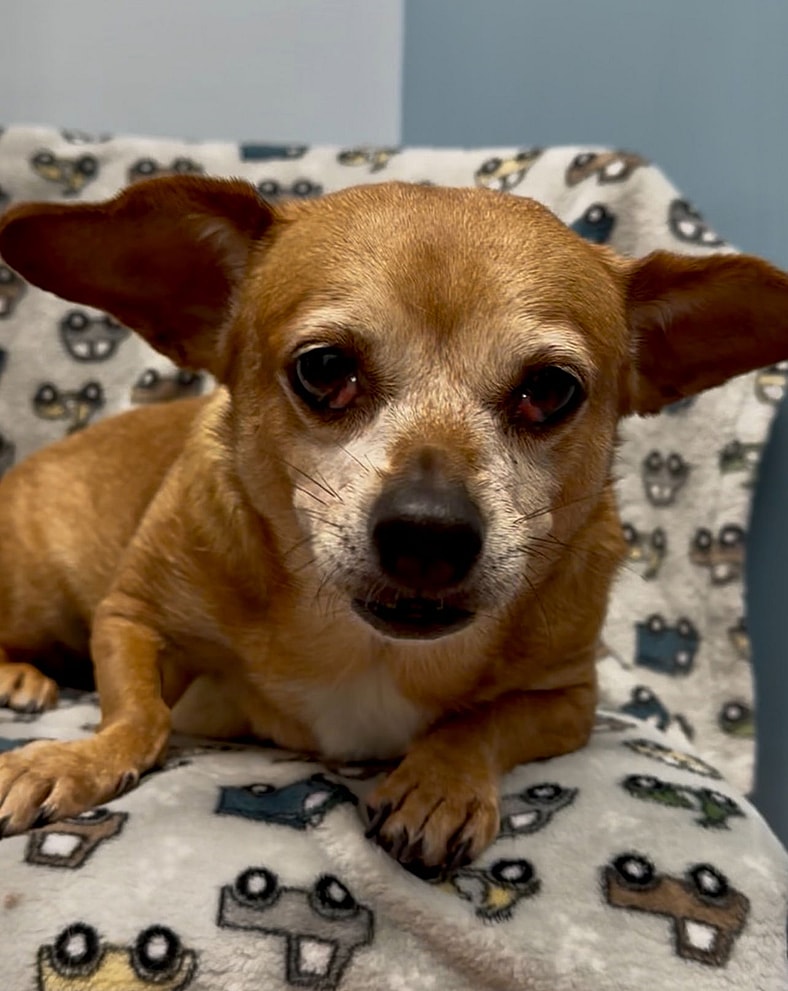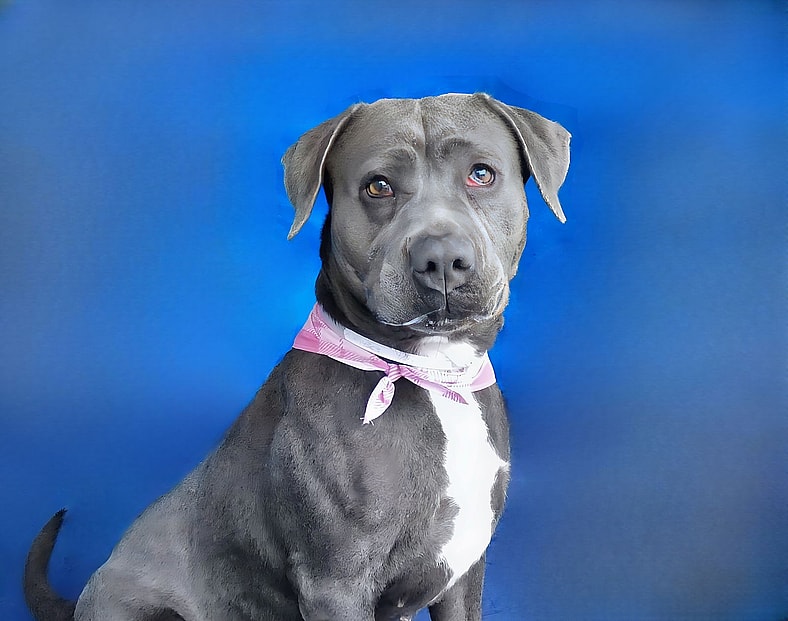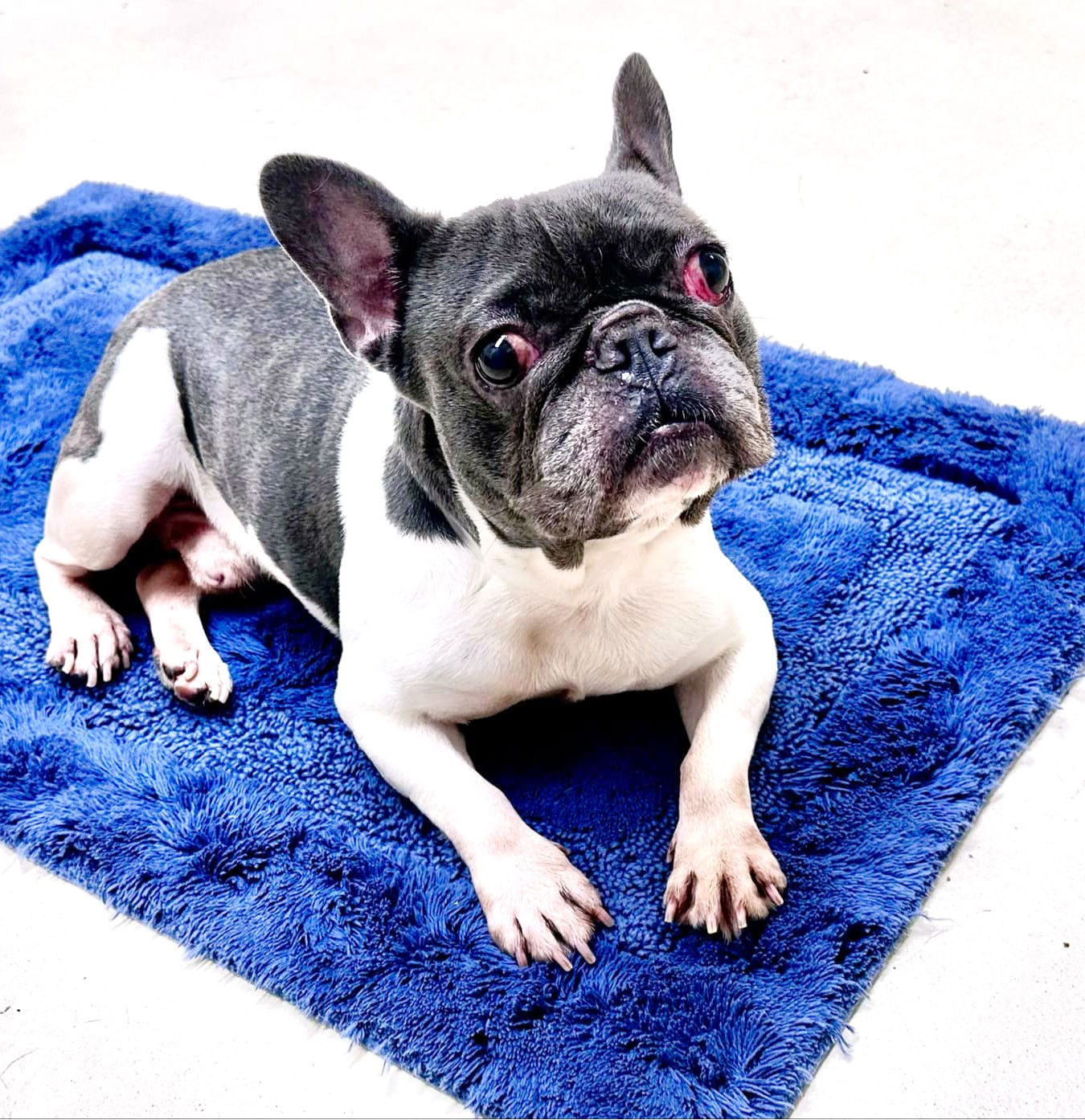Cherry Eye, Big Hearts: These 7 Dogs Are Ready to Be Loved
Dogs with cherry eye often get passed over in shelters simply because of the way they look, but that small red bump doesn’t define who they are. Cherry eye is a common and treatable condition that doesn’t stop these pups from being playful, loving, and incredibly loyal companions.
Sadly, many of them wait far too long for someone to see past the surface and give them a chance. If you’re thinking about adopting, consider opening your heart to a dog with cherry eye. They may not have perfect eyes, but they’re overflowing with love—and they’re just waiting for someone like you.
1. Boots: 6-year-old Calm Pit Bull Mix

Meet Boots — a 6-year-old Pit Bull mix with a heart of gold and the gentlest soul. She arrived at the shelter as a stray on 5/13/2025 and is estimated to weigh under 50 lbs, despite being listed in the 36–75 lb range. Boots has a gorgeous blue and white coat, soft grey eyes, and an unforgettable gaze that speaks volumes. She also has a condition called Cherry Eyes, which will require corrective surgery — a fairly simple procedure that she absolutely deserves.
Boots is everything you want in a best friend: calm, affectionate, and eager to please. She walks beautifully on leash, knows how to sit, and has the kind of loving demeanor that would make her the perfect couch companion. She’s currently fighting a mild cold but remains sweet and social, even sharing her kennel with other dogs. With her intelligence, gentle nature, and endless capacity for love, Boots is just waiting to snuggle up in the forever home she’s dreaming of. Learn More
2. Milo: 10-year-old Sweet Doxie Mix Senior

Meet Milo — a 10-year-old, 20-pound Dachshund mix with a heart full of love and a nose for cozy companionship. Originally adopted years ago, Milo has found his way back to the rescue through no fault of his own and is now hoping for a second shot at a forever home where he can enjoy his golden years in peace.
Milo has great potty manners and enjoys going for walks, but he’s not a fan of kids and would thrive in an adult-only home. He prefers to be the only dog in the house so he can soak up all the love and attention for himself. This sweet boy also has small cherry eyes in both eyes, but they don’t bother him and don’t require treatment. He’s healthy, loyal, and ready to be someone’s best friend all over again. If you’re looking for a calm, affectionate senior to share your days with, Milo may be the perfect match. Learn More
3. Faith: Gentle Giant Cane Corso

Meet Faith, a stunning 5-year-old Cane Corso who’s navigating an unexpected heartbreak. After spending her entire life with one family, she was recently surrendered to the shelter through no fault of her own. Weighing around 90 lbs, Faith is a gentle giant—loyal, affectionate, and craving the stability of a forever home. Her foster dad, Bob, has been helping her recover from cherry eye surgery and says she’s a total sweetheart who loves walks, treats, and being near her people.
Faith does well on leash and in the car and has been around children, but due to her size and strength, a home without small kids would be ideal. She’d also prefer to be the only pet so she can soak up all your love. She’s used to being trusted alone in the house and just wants to be part of a family again. Bob has to return her to the shelter soon, and it’s a heartbreaking thought—Faith is deeply stressed there and truly deserves a second chance in a calm, loving home. Learn More
4. Grace: 4-year-old Loving Pit Bull Mix

Meet Grace, a 4-year-old, 54-pound Pit Bull mix with the silkiest charcoal coat, a snow-dusted chest, and a heart that radiates joy. This sweet girl was surrendered by her previous owner on April 23, 2025, through no fault of her own. Since then, she’s been melting hearts at the Baldwin Park Animal Care Center with her playful, affectionate nature and constant tail wags.
Grace is the total package—potty trained, treat-motivated, and already knows how to “sit”! She’s friendly with everyone she meets and may do well in a home with another calm dog. Though she may have a mild cherry eye, it’s an easy fix and doesn’t dim her light in the slightest. Grace walks well with her handler, takes treats gently, and thrives on human connection. She’s truly the “goodest girl” and would make a wonderful companion in a loving home ready for her bright spirit. Learn More
5. Rumple: 6-year-old Gentle Purebred English Bulldog

Rumple is a 6-year-old purebred English Bulldog who has endured heartbreaking neglect—and still manages to radiate love and trust. Exploited for breeding and then dumped when he was no longer “useful,” Rumple arrived at the rescue in pain: his body ravaged by mange, nails curled into his paw pads, cherry eye, double ear infections, and an infected tail pocket. But thanks to a dedicated medical foster, Rumple is finally getting the care he’s always deserved.
Now on the road to recovery, Rumple is showing his true gentle self. Weighing 50 lbs, he’s laid back, dog-friendly, and reportedly great with kids and cats. He’s house-trained, walks beautifully on leash, and is a chill co-pilot in the car. All Rumple needs now is a calm, loving home to complete his transformation. Could that be with you? Learn More
6. Fetty: Social Butterfly French Bulldog

Meet Fetty — a 5-year-old male French Bulldog with a big personality and an even bigger heart. Fetty recently underwent surgery to correct Cherry Eye, a condition he was born with that caused visible pink bumps in the corners of his eyes. Thanks to the care he’s received, the inflammation has gone down, and with continued medication and love, he’s well on the road to full recovery.
Fetty is sweet, social, and loves greeting both new people and familiar faces. He has done well meeting other dogs at the shelter, and staff recommend a meet-and-greet with your current pup to ensure compatibility. As a French Bulldog, Fetty will need a home that understands the lifelong medical and grooming needs of his breed. In return, you’ll get a devoted companion full of charm, affection, and Frenchie flair. Learn More
7. Jalapeño: Bulldog Mix With a Heart Full of Love

Jalapeño is a 3.5-year-old Bulldog mix with a heart full of love and a face you’ll never forget. Found as a stray on 5/5/2025, this handsome pup weighs around 35 lbs and sports a striking black-and-white coat with soulful brown eyes. While he does have cherry eye, it’s an easy and treatable condition—and it doesn’t stop him from being a total sweetheart.
Jalapeño may be a little shy at first, but he quickly warms up and shows his affectionate, playful side. He waits patiently to be leashed and walks beautifully, only pulling slightly when he’s excited. He lives for pets and praise, and that gentle, eager-to-please gaze of his? Absolutely heart-melting. He seems to be housebroken, is well-behaved, and radiates a calm, friendly energy that makes him easy to fall for. Learn More
1. What is cherry eye in dogs?
Cherry eye in dogs refers to a condition where the tear gland (also called the nictitating membrane gland) in a dog’s third eyelid becomes prolapsed, creating a red, fleshy mass in the corner of the dog’s eye. It’s commonly seen in brachycephalic breeds and lhasa apsos, which are prone to cherry eye.
2. What causes cherry eye in dogs?
The exact cause of cherry eye isn’t fully known, but it’s believed to result from weak connective tissue that fails to hold the tear gland in place. This leads to prolapsed glands and can cause chronic irritation if left untreated.
3. What are the symptoms of cherry eye in dogs?
Symptoms of cherry eye include a red or pink mass in the inner corner of the eye, excessive tearing, squinting, and pawing at the eye. If untreated, cherry eye can lead to infections or even keratoconjunctivitis sicca (dry eye).
4. Can cherry eye in dogs go away on its own?
In rare cases, early stage cherry eye in dogs may temporarily recede, but it almost always returns. Without proper treatment for cherry eye, the condition tends to worsen over time and can lead to dry eye or chronic discomfort.
5. Are there home remedies for cherry eye in dogs?
There are some home remedies for cherry eye in dogs such as warm compresses and gentle massage, which may help reposition the gland in very mild or early cases. However, these are not reliable long-term treatment options and should never replace veterinary advice.
6. How to treat cherry eye in dogs without surgery?
For very early stage cherry eye in dogs, vets might recommend eye drops for cherry eye in dogs or anti-inflammatory medication to reduce swelling. While non-surgical approaches may offer temporary relief, surgery is typically the most effective solution.
7. What is the treatment for cherry eye in dogs?
Treatment for cherry eye often involves surgery to reposition the tear gland, rather than removing it—this preserves eye health and reduces the risk of keratoconjunctivitis sicca. The pocket technique is a common surgical method used.
8. What is the pocket technique for cherry eye in dogs?
The pocket technique is a modern surgical treatment where the prolapsed gland is tucked back into a small “pocket” of tissue and sutured shut, securing it in place and maintaining tear production.
9. How much does cherry eye in dogs surgery cost?
The cherry eye in dogs surgery cost typically ranges from $300 to $800 per eye, depending on location, surgical technique, and whether both eyes are affected. Some complex cases may cost more.
10. Can cherry eye in dogs affect both eyes?
Yes, cherry eyes in dogs can affect one or both eyes. In breeds prone to cherry eye, it’s not uncommon for the second eye to develop cherry eye weeks or months after the first.
11. Is cherry eye painful for dogs?
Yes. The exposed tear gland can become irritated, inflamed, or infected, causing discomfort. Dogs may rub their face or squint, and in severe cases, it can lead to dry eye and vision issues.
12. Which dog breeds are most prone to cherry eye?
Brachycephalic breeds like Bulldogs, Boston Terriers, Pugs, and lhasa apsos are especially prone to cherry eye due to their facial structure and genetic predisposition.
13. What are the risks of untreated cherry eye in dogs?
If left untreated, cherry eye can lead to chronic inflammation, infections, scarring, and keratoconjunctivitis sicca, which can significantly impact your dog’s eye health and quality of life.
14. How can I prevent cherry eye in dogs?
There’s no guaranteed way to prevent cherry eye, but keeping your dog’s eyes clean and avoiding trauma to the eye in dogs may help. Early intervention at the first sign of symptoms is key.
15. How do vets fix a cherry eye in a dog?
Vets usually recommend surgical treatments, such as the pocket technique, to reposition the gland rather than removing it. Removal is discouraged due to the risk it poses to tear production and eye health.



